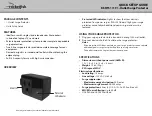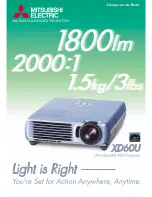
6
2. VIEWER
What you can do with the viewer
Select a saved image or video and project it from this device. The following 3 destinations can be used.
(1) Projector memory: Screen images saved temporarily in the internal memory of this device (known as “capture
images” in this manual).
(2) USB memory: Images and videos inside the USB memory connected to this device.
(3) Shared folder: Images and videos inside the shared folder on the network connected to this device.
Top screen of the viewer
Projector memory
USB memory
Shared folder
Settings
• See the user's manual of the projector on how to store captured images in the projector memory.
• Select [SETTINGS] to change the settings for the slide show, videos, shared folders and so on.
• While "Autoplay" has been set either to "Still image" or "Video" in the Settings, the projector starts performing "Au
-
toplay" by the operation in below:
- When the Viewer top screen is displayed on, a USB memory is connected in the projector.
- When the Viewer screen is displayed on first time after powering ON the projector in which a USB memory has
been connected.
For starting "Autoplay", the system will automatically search both the root directory and the folders in the subse
-
quent level in the USB memory and then display found still images or videos in order. The images and videos will
be displayed in the "Sorted" order.
NOTE:
• Only 1 USB memory can be recognized by the viewer. Do not connect the USB memory to the USB port of this device used for
connecting to a wireless LAN.
• 1 to 4 shared folders can be set.
• When the connection to the shared folder fails, an error message is displayed and an “x” is displayed in the folder icon. Carry out
the following checks in this case.
• Is the LAN cable connected correctly?
• Is the name of the destination folder correct?
• Is the destination folder set for sharing?
• Have access rights been set in the destination folder?
• Are there any displayable files saved in the destination folder?
• Is date and time set correct?







































